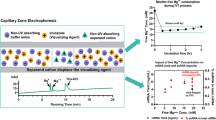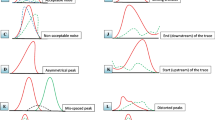Abstract
PCR is a commonly used and highly efficient technique in biomolecular laboratories for specific amplification of DNA. However, successful DNA amplification can be very time consuming and troublesome because many factors influence PCR efficiency. Especially GC-rich DNA complicates amplification because of generation of secondary structures that hinder denaturation and primer annealing. We investigated the impact of previously recommended additives such as dimethylsulfoxide (DMSO), magnesium chloride (MgCl2), bovine serum albumin (BSA), or formamide. Furthermore, we tested company-specific substances as Q-Solution, High GC Enhancer, and Hi-Spec; various actively promoted polymerases as well as different PCR conditions for their positive effects on DNA amplification of templates with moderate and extremely high CG-content. We found considerable differences of specificity and quantity of product between different terms. In this article, we introduce conditions for optimized PCR to help resolve problems amplifying moderate to high GC-rich templates.


Similar content being viewed by others
References
Hube, F., Reverdiau, P., Iochmann, S., & Gruel, Y. (2005). Improved PCR method for amplification of GC-rich DNA sequences. Molecular Biotechnology, 31, 81–84.
Frey, U. H., Bachmann, H. S., Peters, J., & Siffert, W. (2008). PCR-amplification of GC-rich regions: ‘slowdown PCR’. Nature Protocols, 3, 1312–1317.
Shore, S., & Paul, N. (2010). Robust PCR amplification of GC-rich targets with Hot Start 7-deaza-dGTP. BioTechniques, 49, 841–843.
Chakrabarti, R., & Schutt, C. E. (2001). The enhancement of PCR amplification by low molecular-weight sulfones. Gene, 274, 293–298.
Henke, W., Herdel, K., Jung, K., Schnorr, D., & Loening, S. A. (1997). Betaine improves the PCR amplification of GC-rich DNA sequences. Nucleic Acids Research, 25, 3957–3958.
Chakrabarti, R., & Schutt, C. E. (2001). The enhancement of PCR amplification by low molecular weight amides. Nucleic Acids Research, 29, 2377–2381.
Farell, E. M., & Alexandre, G. (2012). Bovine serum albumin further enhances the effects of organic solvents on increased yield of polymerase chain reaction of GC-rich templates. BMC Research Notes, 5, 257.
Kreader, C. A. (1996). Relief of amplification inhibition in PCR with bovine serum albumin or T4 gene 32 protein. Applied and Environment Microbiology, 62, 1102–1106.
Kramer, M. F., & Coen, D. M. (2001). Enzymatic amplification of DNA by PCR: Standard procedures and optimization. Current Protocols in Immunology, 24, 10.20.1.
Hardjasa, A., Ling, M., Ma, K., & Yu, H. (2010). Investigating the effects of DMSO on PCR fidelity using a restriction digest-based method. Journal of Experimental Microbiology and Immunology (JEMI), 14, 161–164.
Jensen, M. A., Fukushima, M., & Davis, R. W. (2010). DMSO and betaine greatly improve amplification of GC-rich constructs in de novo synthesis. PLoS ONE, 5, e11024.
O’Connell, J. (2002). An RT-PCR-based protocol for the rapid generation of large, representative cDNA libraries for expression screening. Methods in Molecular Biology, 193, 363–374.
Abu Al-Soud, W., & Radstrom, P. (2000). Effects of amplification facilitators on diagnostic PCR in the presence of blood, feces, and meat. Journal of Clinical Microbiology, 38, 4463–4470.
Nagai, M., Yoshida, A., & Sato, N. (1998). Additive effects of bovine serum albumin, dithiothreitol, and glycerol on PCR. Biochemistry and Molecular Biology International, 44, 157–163.
Pletsch, N. (2003). Assoziationsanalysen im TGFα- und TGFβ3-Gen bei Patienten mit Lippen-Kiefer-Gaumenspalten und Gaumenspalten. Marburg: Philipps-Universität Marburg.
Henegariu, O., Heerema, N. A., Dlouhy, S. R., Vance, G. H., & Vogt, P. H. (1997). Multiplex PCR: Critical parameters and step-by-step protocol. BioTechniques, 23, 504–511.
Chester, N., & Marshak, D. R. (1993). Dimethyl sulfoxide-mediated primer Tm reduction: A method for analyzing the role of renaturation temperature in the polymerase chain reaction. Analytical Biochemistry, 209, 284–290.
Conflict of interest
The authors declare no competing interests.
Author information
Authors and Affiliations
Corresponding author
Rights and permissions
About this article
Cite this article
Strien, J., Sanft, J. & Mall, G. Enhancement of PCR Amplification of Moderate GC-Containing and Highly GC-Rich DNA Sequences. Mol Biotechnol 54, 1048–1054 (2013). https://doi.org/10.1007/s12033-013-9660-x
Published:
Issue Date:
DOI: https://doi.org/10.1007/s12033-013-9660-x




